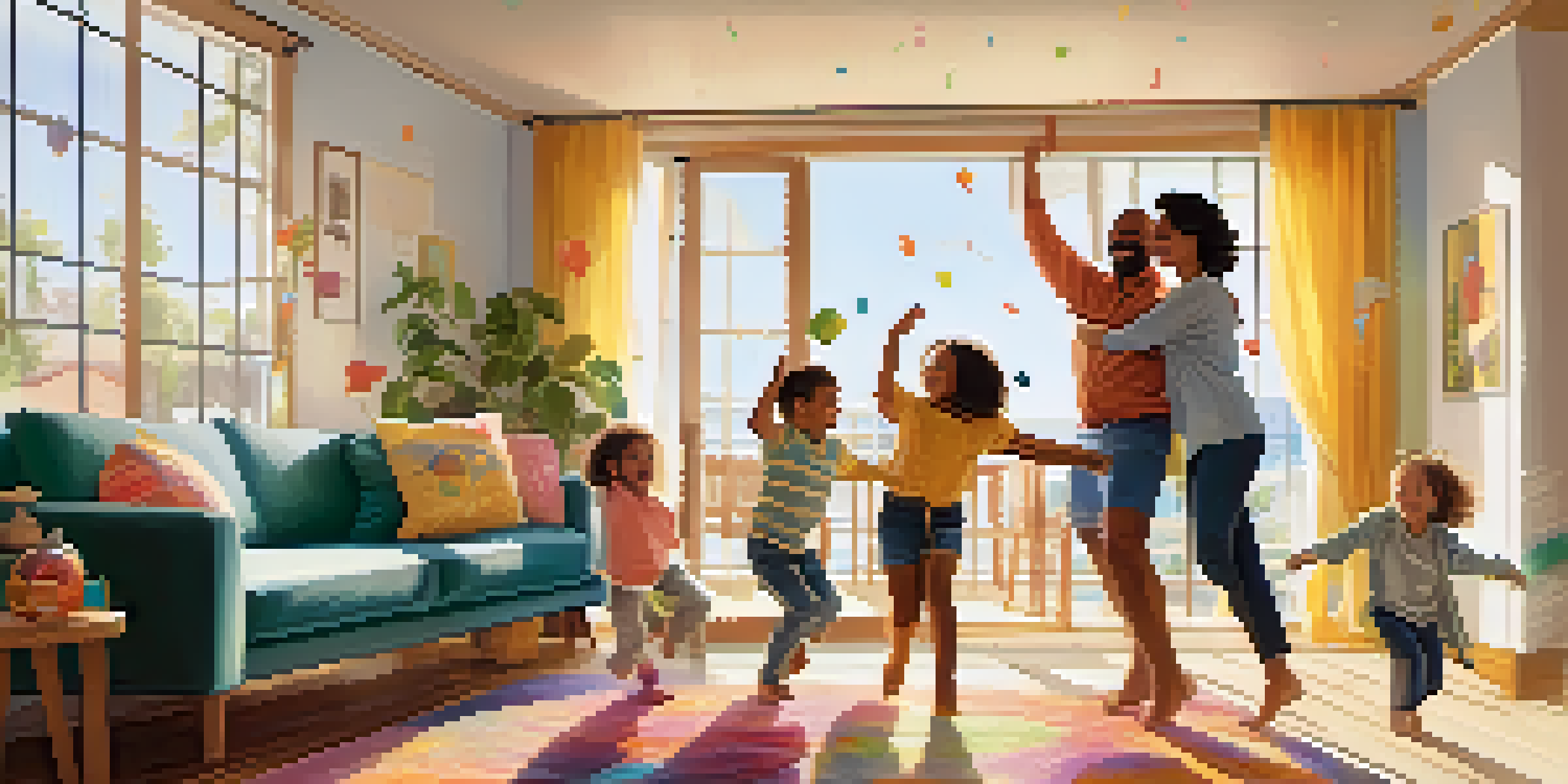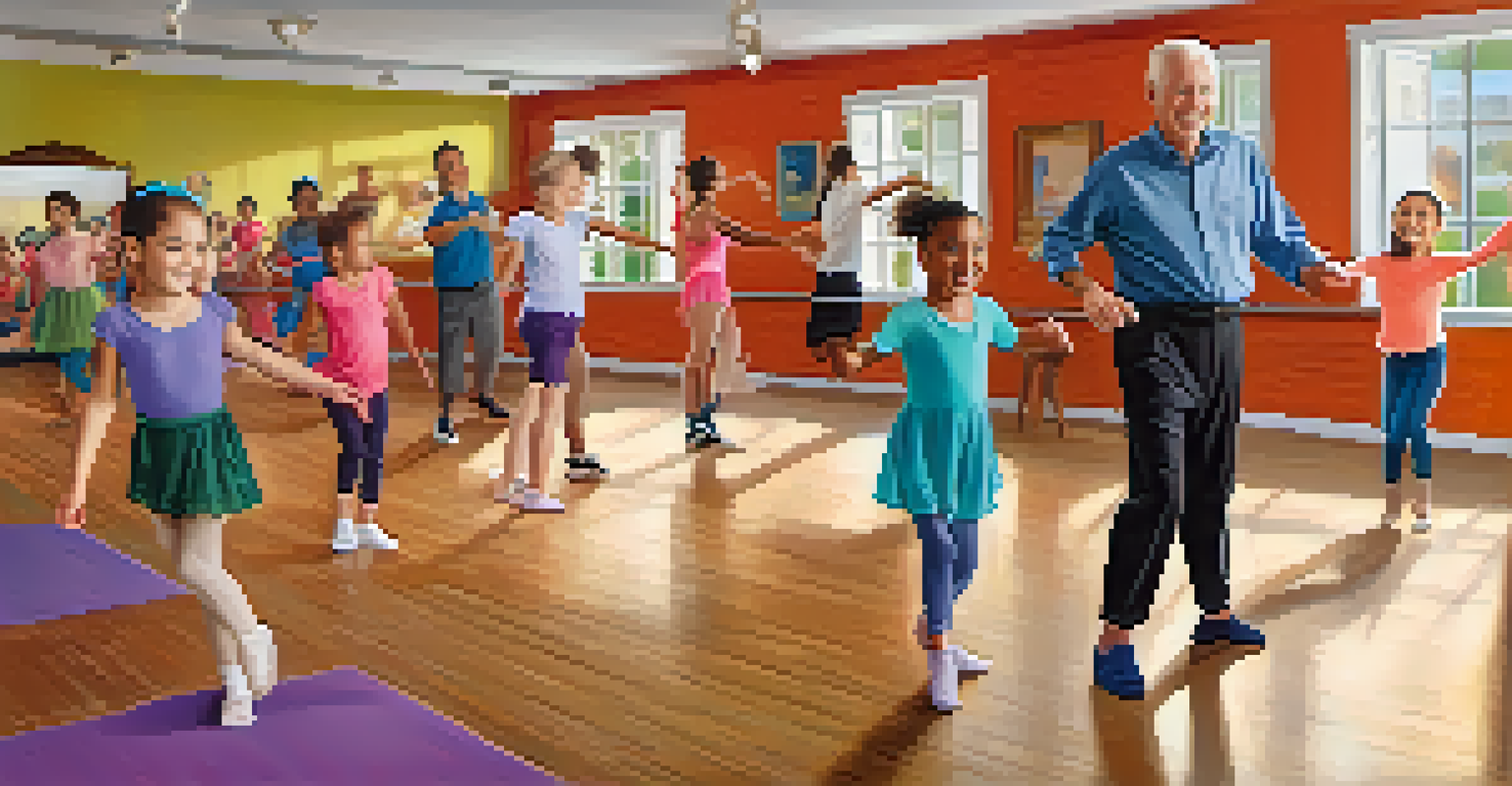The Impact of Dance on Family Bonding and Communication Styles

How Dance Fosters Connection Among Family Members
Dance creates a unique space where family members can connect on a deeper emotional level. Through shared movements and rhythms, families can express their feelings and experiences in a way that words sometimes can't capture. This shared physical activity promotes a sense of unity, making everyone feel more connected.
Dance is the hidden language of the soul.
When families dance together, they often engage in laughter and fun, which can break down barriers and ease tensions. Whether it’s a casual living room dance party or a structured family dance class, the joy of movement can transform the atmosphere, turning it into a space filled with love and support. This can be especially beneficial during challenging times.
Furthermore, dancing together helps create lasting memories that strengthen familial ties. These shared experiences often become cherished stories that families recount, reinforcing their bond and creating a sense of belonging that lasts well beyond the moment.
Dance as a Tool for Improving Communication Skills
Engaging in dance can significantly enhance communication styles among family members. It encourages non-verbal communication, allowing individuals to express feelings and emotions through movement rather than words. This can lead to a better understanding of each other's emotional states, fostering empathy and connection.

For instance, a simple dance routine requires participants to be aware of each other's movements and intentions. This attentiveness can translate into better listening skills and responsiveness in verbal communication as well. Families who dance together often become more attuned to each other's needs, which is crucial for healthy relationships.
Dance Builds Family Connections
Engaging in dance fosters emotional bonds among family members by creating shared experiences that enhance feelings of unity.
Moreover, dance provides an opportunity for families to practice teamwork and cooperation. As they navigate choreography or create freestyle routines, members learn how to work together towards a common goal, enhancing their ability to communicate effectively in other areas of family life.
The Role of Music in Enhancing Family Dance Experiences
Music plays a pivotal role in making family dance sessions enjoyable and engaging. It sets the mood, energizes the participants, and can even evoke memories associated with certain songs, enriching the experience. Choosing music that resonates with everyone can create a shared atmosphere of joy and nostalgia.
Dancing is like dreaming with your feet.
Additionally, music can serve as a bridge across generational gaps. Different family members might prefer various genres, but creating a playlist that includes everyone’s favorites fosters inclusivity and respect for each other's tastes. This collaborative approach can further enhance the family bond by encouraging discussions about music preferences.
Ultimately, music not only enhances the dancing experience but also strengthens emotional connections within the family. The act of dancing to a shared soundtrack can create a sense of harmony, lifting spirits and enhancing the overall experience.
Creating Family Traditions Through Dance
Establishing dance as a family tradition can be a powerful way to strengthen bonds over time. Whether it’s a weekly dance night, a special dance at family gatherings, or participating in local dance events, these traditions can provide families with something to look forward to. They become rituals that reinforce togetherness and create lasting memories.
For example, many families find joy in celebrating milestones through dance, such as birthdays or anniversaries, where they can create choreography together or simply enjoy a favorite song. These moments become a part of the family narrative, contributing to their unique identity and sense of belonging.
Improves Communication Skills
Dance encourages non-verbal communication, helping family members express emotions and understand each other better.
Moreover, as children grow and families evolve, these traditions can adapt, making them inclusive for all ages. This adaptability ensures that every family member continues to feel valued and included, further solidifying those important familial bonds.
Dance as a Form of Expression in Family Dynamics
Dance offers a unique way for family members to express their individuality while still being part of a collective group. Each person brings their style and personality to the dance floor, showcasing their unique traits. This can foster acceptance and appreciation of each other’s differences, enhancing family dynamics.
For instance, a shy family member may find their voice through dance, expressing emotions they might struggle to articulate verbally. This can lead to deeper conversations about feelings and experiences, promoting a healthier family environment where everyone feels safe to express themselves.
Additionally, dance can help resolve conflicts by providing an outlet for emotions. Families can channel frustrations or anxieties into movement, allowing for catharsis and leading to healthier communication afterward. This expression can be a vital tool in maintaining harmony within the family unit.
Physical Benefits of Dance for Family Well-being
The physical benefits of dance are numerous, contributing to the overall well-being of the family. Dancing is a fun way to stay active, promoting cardiovascular health, flexibility, and coordination. When families engage in dance together, they not only improve their fitness but also encourage a culture of health and wellness.
Moreover, regular physical activity through dance can enhance mood and reduce stress levels. The endorphins released during dancing create a sense of happiness, which can positively impact family relationships. Families that dance together often find themselves more relaxed and joyful in each other’s company.
Dance as a Therapeutic Outlet
Participating in dance provides families a constructive way to cope with stress and emotional challenges, promoting healing together.
Incorporating dance into family routines can also establish healthy habits from a young age. Children who grow up with active lifestyles are more likely to continue these habits into adulthood, fostering a lifelong appreciation for movement and health.
The Therapeutic Aspects of Dance in Family Life
Dance can serve as a therapeutic outlet for families, providing a means to cope with stress and emotional challenges. Engaging in dance allows family members to release pent-up emotions and tension in a constructive way. This can be especially beneficial during difficult times, offering a form of relief and a way to process feelings together.
For instance, some families turn to dance as a way to commemorate lost loved ones or navigate significant life changes. By coming together in movement, they can honor their emotions and support one another through the healing process. This shared experience can foster resilience and strengthen familial ties.

Furthermore, dance therapy has been recognized for its psychological benefits, including improved self-esteem and emotional regulation. Families that embrace dance as a healing practice may find themselves more equipped to face challenges together, reinforcing their bond and enhancing communication.
Conclusion: Embracing Dance for Stronger Family Connections
In conclusion, dance is much more than just a form of entertainment; it’s a powerful tool for enhancing family connections and communication styles. By engaging in dance, families can foster deeper bonds, improve their communication skills, and create lasting memories together. The physical and emotional benefits of dance further enrich family dynamics, making it an invaluable component of family life.
As families navigate the ups and downs of life, incorporating dance into their routines can provide a joyful escape and a means of connection. Whether it's through spontaneous living room dancing or organized family classes, every moment spent dancing together contributes to a stronger family unit.
So, gather your loved ones, turn up the music, and let the rhythm guide you to deeper connections and stronger communication. Embracing dance can truly transform the way families relate to one another, creating bonds that last a lifetime.